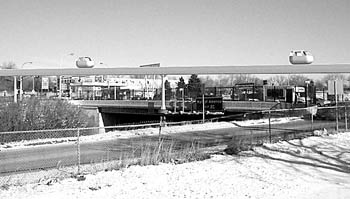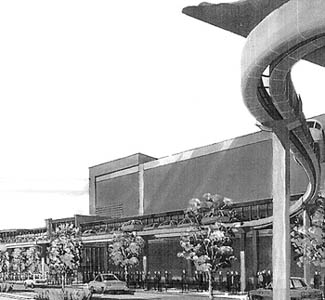![[Metroactive News&Issues]](/gifs/news468.gif)
[ Santa Cruz Week | SantaCruz Home | Archives ]
I Can See Your House From Here: Stone-age PRT technology in action.
High Soar or Eyesore?
A novel idea for sky-high Santa Cruz transit is stirring up controversy
By Rebecca Patt
EVER WONDERED why the cavemen forever riding back and forth on the Sky Glider at the Boardwalk are grinning? A group of visionaries thinks it's because these Neanderthals are onto something good--a revolutionary solution to Santa Cruz's traffic woes.
Amusement parks and ski resorts have been building these high-flying methods of getting from A to B for years, but as the cavemen suggest, these versions are primitive compared to the progressive systems, known as Personal Rapid Transit, that engineers are now developing for urban use.
Advocates tout PRT as a major breakthrough in urban transportation, because it gets people around while keeping them out--and above--congestion.
"A number of people, once they understand it, comment that it is the next major innovation after the steam locomotive, the automobile and the airplane," says Dr. Edward Anderson, a leading PRT designer and researcher. "If you want to do something about congestion, you can't solve it by having something else on the surface. You have to go to an elevated system, and we've tried to make it look as good as possible."
So, it should come as no surprise to learn that in alternative-minded Santa Cruz a movement is underway (make that overway, perhaps) to get a PRT project off the ground, which, incidentally, proponents say is the only direction left for traffic to go. The local chapter of CPRT (Citizens for Personal Rapid Transit) wants to build the country's first modern PRT system, from Harvey West Park (near the Highway 1 and Highway 9 intersection) to the UCSC bookstore.
Critics, meanwhile, say that the two-way track, which would potentially run along the southern boundary of the Pogonip--the greenbelt that slopes from campus down to the city--is the transportation equivalent of a novelty toy and will only distract from what they consider more serious considerations, like the widening of Highway 1.
Up With People
If you can picture the Boardwalk's version, then you can grasp the PRT's basic concept, but instead of benches and cables, it would use three-passenger pods that travel on slim guideways.
The guideways are 16 feet off the ground and supported by columns that require a 20-inch circle every 90 feet. Imagine a cement redwood popping up every third of a football field on a system no wider than a bike lane, and you get the idea.
Proponents say the three-passenger pods will make the system lighter and more economical, and the trip more personal--and kinkier in a ménage à trois kind of a way-- all while offering sweeping views of the Pogonip. The Buck Rogers-looking capsules would do 35 miles per hour, traveling behind each other at a rate of one car every six-tenths of a second, 24 hours a day and nonstop to any station in the network via a computer-controlled system.
"One of the secrets that makes it good is the off-line station," said Walworth. "You never stop while somebody gets on or off."
Supporters are trying to head off complaints that the system will be an eyesore by touting its efficiency.
"It's no more intrusive than a chairlift on a ski slope," says Dave Walworth, head of the local PRT booster club. "People say, 'I don't want things like that running by my house,' and it's hard to argue with that, but it will look better than a street full of cars and buses. And it's nonpolluting, and it's silent."
They also reject the critics' prediction that the system will be too expensive, saying it's the cheapest to build and operate of any modes of mass transit, costing approximately $6 million per mile, versus about $40 million per mile for light rail and $30 million for one mile of a single lane of highway, by their estimation. (The operating cost is estimated to be 15 cents per mile compared to more than 50 cents for rail or buses.) And Walworth estimates the PRT system to UCSC would cost $18 million to build, with passengers paying 40 cents a mile.
The beauty of PRT, argue advocates, is it can transport as many people as a three-lane highway while disturbing little surface area. Each car is electrically propelled with its own silent, energy-efficient motor, the same technology that makes it possible for roller coasters to go up steep hills, but apparently without all the clackety-clack.
Too Out There To Go Up There?
Although urban PRT has been around since the 1950s, few systems have actually been built, leaving proponents little data on which to base arguments and critics plenty of ways to shoot them down.
An expensive early model--now considered out of date and inefficient--was built in the 1970s at the University of West Virginia in Morgantown. Currently, the first modern PRT is under construction in Cardiff, Wales. And in 2000, the city of Santa Cruz' Transportation Commission voted unanimously to consider PRT in the future.
If this first installation up to UCSC is successful, supporters envision PRT lines extending in a network that includes loops to all the colleges, from Front Street to the Boardwalk, from Bay Street to UCSC, and eventually beyond the city to Watsonville and San Jose.
On June 20, a steering committee votes on the final draft of the city's master transportation plan. If PRT gets the thumbs up, the vote would be a landmark victory for PRT radicals. But while PRT pioneers say they could get the system up and running in five years, they face several huge obstacles.
First, they need to convince key officials and the public that PRT is the best new transportation investment. Then they would need the green light to build in the Pogonip, which entails getting a majority vote from the Santa Cruz City Council as well as permission from the Cowell Foundation, the group that deeded the land to the city but still retains some influence over its use. Again, no easy task.
In fact, it all adds up to what some say is an impossible mission. Linda Wilshusen, executive director of the Santa Cruz County Transportation Commission--the group that gives federal money for regional transportation projects--is one of those who is skeptical about PRT.
"Let's see how it works in Cardiff, Wales, and how much it costs, and then look at it again," she said. "Right now, the commission's priority is to widen Highway 1. A lot of time and effort is being focused on that--and will be in the future."
The county is considering a $240 million project to widen Highway 1 from Morrissey Boulevard to State Park Drive.
"The bottom line is that I don't think our small little county has the financial wherewithal to be engaging in a project like this," said Ian McFadden, Santa Cruz Metro Transit planner. "Until someone proves it can be done, I think we ought to be working on transportation projects that are tried and true."
Peter Beckmann, owner of Beckmann's Bakery and a member of the master transportation plan steering committee, objects to PRT on a philosophical level. He thinks the small cars would promote a sense of isolation.
"It doesn't contribute to community," he said. "We are moving farther and farther apart, and we need to create ways to bring us together."
High Spirits
Some officials, however, are championing the PRT cause. City Councilmember Ed Porter is among those who have already jumped on the bandwagon.
"Santa Cruz is a modest-to-small-sized town with a world-class transportation problem," said Porter. "We don't want to pave all this over. We can accommodate people, but we can't accommodate a never-ending increase in the number of cars."
No other solutions to the parking nightmare at UCSC are currently on the table, even as the university population is expected to increase by 1,500 students by 2010. The university has considered building an eastern access road along the edge of the Pogonip since the 1960s, but the idea has been shelved due to unpopularity and concerns that it would only create more congestion. A rail line up to campus has also been proposed, an idea on hold until the county acquires right-of-way from Union Pacific.
Ex-Mayor Mike Rotkin, member of the UCSC Transportation Committee and a candidate in the upcoming City Council election (also a self-professed "car hater"), said he is open-minded about the idea of bringing the PRT to UCSC, but wants to find out more about the specifics of the proposal.
"A lot of the other types of technology we've looked at have not been feasible," he said. "I think PRT is kind of interesting, but I haven't seen a plan and nobody's laid out anything yet."
And that leaves the important question: if Santa Cruz indeed installs a futuristic PRT, will fake cavemen passengers ride in a few of the capsules?
"Absolutely," said Porter. "They can go all over town and back to the Boardwalk."
Copyright © Metro Publishing Inc. Maintained by Boulevards New Media.
![]()

Photograph by Stephen Laufer

Time Capsule: Could this be the future of Santa Cruz transit?

From the June 19-26, 2002 issue of Metro Santa Cruz.